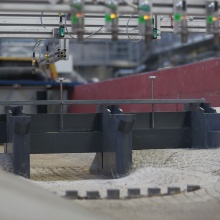Interdisciplinary studies are required when investigating environmental systems. This field brings together expertise from the fields of engineering, microbiology and chemistry to better understand systems such as the biostabilisation of river and reservoir systems.
Key research questions address the following aspects. Firstly, the seasonal and spatial variation in the biostabilisation of fine sediment dynamics is investigated. Secondly, once sediment is eroded from the bed, the influence of microbial biostabilisation on the characteristics of the entrained material, or flocs, is addressed. The impact on floc characteristics, in turn, influences the transport or fate of fine material in these watercourses.
The biostabilisation working group (BIOSTAB) focuses on the significance of different microorganisms, to taxa and species level, on the biostabilisation of sediment, as well as the reciprocal influence of hydrodynamic conditions and the biofilm topography and architecture. Furthermore, the influence of micropollutants on the functionality and growth of biofilm is investigated. All of the above findings should provide contextual data to implement microbial biostabilisation in future numerical sediment transport models.
The colonisation of surfaces by microbial organisms can result in a diverse biofilm. Pioneer bacteria will settle on a surface which then promotes the attachment of protozoa and microalgae. The bacterial community is determined through a variety of molecular and genetic techniques (PCR, FISH, DGGE) in collaboration with Prof. Werner Manz, Institute for Integrated Science, University of Koblenz-Landau, PD Dr. Michael Schweikert from the Institute of Biomaterials and Biomolecular Systems (IBBS), University of Stuttgart and with Prof . Dr. Ursula Obst, KIT Institute of Functional interfaces.
The microalgae present in biofilms are determined both qualitatively and quantitatively in collaboration with Dr Lydia King, Freiburg (diatoms) and Prof. Dan Dietrich, Human and Environmental Toxicology, University of Konstanz (Cyanobacteria / blue-green algae).
Although the biofilm matrix is mainly composed of water (>90%), other important components such as extracellular DNA, sugars, proteins and lipids are present, as well as many combinations such as glycoproteins. These substances are collectively termed “extracellular polymeric substances or EPS” as they are secreted by the micro-organisms present as opposed to the internal components of the cells. In order to carefully separate the extracellular and intracellular components, relatively ‘gentle’ extraction methods are used (Cation Exchange Resin or CER), followed by quantitative and photometric determination of the main components of the colloidal fraction of EPS in the wet lab of BIOSTAB.
The presence of EPS and micro-organisms on a sediment bed can increase the adhesion or ‘stickiness’ of the surface. This adhesion is important for the stability of the sediment and for the trapping and binding of particles from the overlying water column during deposition. This adhesion is measured using the Magnetic Particle Induction (MagPI) method (Figure 7).
In order to determine the influence of biostabilisation on the critical erosion threshold of sediments beds, the SETEG flume (An in-house built flow channel) is used. Herewith, the biofilm surface is exposed to the flow within the channel (open bottom) and the flow velocity is enhanced in defined increments until bed failure occurs. From hydraulic calibration the bottom shear stress is known as a function of the controlled flow rate. This can be extended by e.g. lifting sediment cores up by a motor to measure erosion as a function of depth at shear stresses up to 15 Pa. In addition, the erosion rate can be determined using the Sediment Erosion Rate Detection by Computerised Image Analysis (SEDCIA) system. SEDCIA calculates the erosion rate based on the differences in surface elevation detected by lasers aimed at the sediment surface (See the MMM research group pages for more information (Forschungsschwerpunkt MMM ).
The biofilm rich sediment beds can also be inserted into an annular erosion chamber (Gust microcosm, Figure 8). Once the biofilm and sediment has been resuspended this material can be collected and further analysed. As the sediment is now bound with EPS it no longer erodes as individual particles, instead aggregates of sediment particles plus organic matter/biofilm are released into the water column as ‘flocs’. These flocs are known to behave differently from the constituent mineral components. The differences in floc characteristics can be detected by carefully transferring the flocs to a settling chamber in which individual flocs are imaged using CCS camera (Figure 9) and characteristics evaluated using a self-developed Matlab code (Daniela Santolamazza, Master Thesis, 2013).
Projects
| Title | Description |
|---|---|
| Margarete von Wrangell Habilitations Stipendium | Laufzeit: 01.09.2008 bis 31.08.2013 Abteilung: LWW |
| Die Veränderung der Sedimentstabilität und der Charakteristika aufgewirbelter Sedimentflocken durch mikrobiell produzierte extrazelluläre polymere Substanzen (EPS) | Laufzeit: 01.06.2011 bis 31.08.2015 Abteilung: LWW |
| Kriterien für Gestaltung, Betrieb sowie Unterhaltung von Stau- und Retentionsanlagen zur Gewährleistung der ökologischen Durchgängigkeit | Laufzeit: 01.08.2004 bis 31.07.2006 Abteilung: VA |
| CHARM - CHAllenges of Reservoir Management - Meeting Environmental and Social Requirements | Laufzeit: 01.01.2016 bis 31.03.2021 Abteilung: LWW, VA |
| Using high spatio-temporal resolution measurements to determine functional relationships between cohesive sediment erosion and sediment properties | Laufzeit: 01.11.2016 bis 30.06.2021 Abteilung: LWW, VA |


